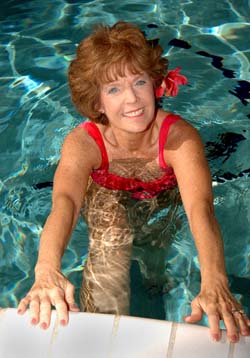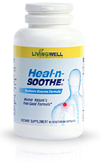Your escape from back pain could be as close as the nearest pool.
It’s not just kids that love a trip to the swimming pool — your back does, too. Water has an amazing power to help you heal and nurture your muscles, but most people prefer pills and surgery.
That approach certainly suits Big Pharma and hospitals, but you can do better. In fact, Japanese researchers looking at back pain sufferers found that 90% reported significant reductions in pain after just six months of pool time twice a week — even if they had no swimming skills!
Of course, that doesn’t mean you should just jump in the pool and start flailing around. Swimming is good for back pain only when you go about it the right way. Find out what to do — and an easy way to boost water’s benefits for your body – with these proven back pain tips.
Warning: Focus on Form
To stop back pain with pool time, you want to do things right. This means focusing on your form while you’re in the water and giving careful attention to your body’s movements. Remember, the goal is to make yourself feel better — and here’s how to make swimming do that for you:
- Focus on your form. Even if you’re an experienced swimmer, go back to basics on the different strokes and kicks. By focusing on doing each move fully and correctly, you’ll nurture your muscles and avoid overuse injuries.
- Try forms that are gentle on your head, neck and spine. For example, the breaststroke can aggravate upper back pain if you’re jutting your chin and neck forward, while the backstroke can help you expand your range of motion but keep your neck in better alignment. Twisting strokes, like a front crawl, may be hard for those with mid-to-lower back pain. All bodies are different — listen to yours and don’t be afraid to make changes!
- Use floats, tubes, noodles and even snorkels. They’re all valuable ways to help you keep good form, so who cares how they look? Plus, using these tools will help you feel safer and stronger in the water, encouraging you to do a full session and stick with it.
- Relax! One of the big advantages to pool work for back pain is that it’s relaxing. Forget about competing with the lap swimmers or racers. This is something you’re doing for yourself, so take it slow, keep your movements fluid and relish the back pain relief your time in the water can bring.
Exercise 1: Wall Circles
Wall circles are an easy place to start in the water, especially if you’re not an accomplished swimmer. These simple exercises take advantage of the natural buoyancy of your body in water to give you a great low-impact workout that will help your muscle alignment and range of motion.
Walk along the wall of the pool until you are neck deep in the pool. Thanks to buoyancy, you’ll now feel only 10% of your body’s weight. Put your body perpendicular to the wall, holding on with one hand. Next, take your foot and draw a half circle along the floor of the pool. Do 5 — 10 circles, then do the other side the same way. Repeat 3 to 5 times, as comfortable.
After working your legs, turn to your arms. Extend the hand not holding the wall straight out away from your body. Thinking of your arm as a solid piece from your shoulder to your hand, draw a small circle under the water, as though you were circling a tennis ball. Do 5 to 10 circles then switch sides. Repeat these sets 3 to 5 times as comfortable.
Why circles? They’re great for opening up your major joints and expanding your range of motion. On land, our bodies almost never do circular motion, but in water it’s easy. This lets you work your muscles in different ways to build balance and strength while removing stiffness, tightness, and pain. If you want to do even more, combine side leg raises with the circle sets to build lower body strength.
Exercise #2: Water Walking
To work your lower body and stretch out tight quads and hamstrings, turn to water walking. This is a great exercise to do in water that is waist deep to chest deep, as you’ll get a 50 — 70% break on feeling your own body’s weight but still benefit from the gentle resistance of the water.
Water walking is a slow, deliberate step through the water where your foot moves all the way up to kick yourself in the rear before getting set back down. You’ll get a full range of motion stretch on your legs and have the chance to open up your knee and hip flexors.
Focus on smooth actions and stability to maximize your benefits. If you’re wobbling, slow down and focus on your balance. If getting your foot all the way up to your rump is an issue, do what you can. Keep the focus on continuous motion and gradual improvement. Remember, water walking isn’t a race walk, and it’s a range of motion that would be hard to achieve on land. While it can be a challenge, there’s no doubt that it loosens and stretches the major leg muscles that can contribute to muscle imbalances and back pain.
Exercise #3: No-Twist Swimming
Spine twists are easy in the water — but they’re usually the result of poor form. Think of a swimmer popping their head in and out of the water. Competitive swimmers in good form are actually turning their whole torso to keep their head in alignment with their spines, but casual swimmers often just twist their necks or spines piecemeal without focusing on the alignment. This can lead to unwelcome pain and potential injuries — exactly the opposite of what you want.
Instead of taking risks, opt for no-twist swimming. Breaststroke and backstroke are good places to start (just remember to tuck your chin on your breaststroke to protect your neck). Back floats and treading water also let you take advantage of water’s buoyant powers to work your back muscles without straining your spine.
Bonus Tip: Combine Swimming with Heal-n-Soothe® for Faster Back Pain Relief
Swimming offers solid, low-impact exercise for sore back muscles. Yet you can speed up your muscle recovery time and cut your back pain by linking swimming with Heal-n-Soothe®.
Heal-n-Soothe® is designed to help your body fight painful inflammation around muscles and joints by reactivating and supplementing your proteolytic enzymes. These unique enzymes are nature’s tool for sweeping away the fibrin your body rushes to all your injuries, aches and pains.
Fibrin is a cushioning healer controlled by your nervous system. But where it builds up, you get stiffness and restricted mobility that can lead to muscle imbalances and back pain. And unfortunately, as you age, fibrin has a tendency to accumulate faster and trigger chronic inflammation, pain, and muscle tension due to less proteolytic enzymes available to sweep the excess fibrin away.
Reverse the trend and reclaim your health with a one-two punch at your pain. Get in the pool at least twice a week to work your muscles and strengthen your body. Then, when you get out of the pool, take Heal-n-Soothe® to work on your body’s pain from the inside out. The combination of low-impact exercise and natural inflammation fighting can help you reclaim your full range of motion and a pain-free life — but only if you’re willing to give this pain-fighting pair a try today.
References
AquaTopics. The Aquatic Environment — Qualities of Water. 2008 Oct 15.
Ariyoshi M, et. al. Efficacy of aquatic exercises for patients with low-back pain. Kurume Medical Journal. 1999;46(2):91-6.
Buch, L. Swimming can be a great workout for those with back pain. The Denver Post. 2010 May 17.
Cannone, J. Pool Exercises for Lower Back Pain. LoseTheBackPain.com. 2011 June 29.
Gallagher, T. Lifecoach: Is swimming the best exercise for a bad back? The Telegraph UK. 2012 Jan 29.
Hefferon, S. Water Exercises for Back Pain. LoseTheBackPain.com. 2010 Oct 21.
O’Connor, A. Ask Well: Swimming to Ease Back Pain. The New York Times. 2013 Feb 15.
Simon, H. Back pain and sciatica — Exercise and Physical Therapy. University of Maryland Medical Center. 2009 May 13.




Thank you for this! I was just looking for something to show my sister to get her to join me in water aerobics today! I have spondylosis and regular participation in water aerobics, water walking, swimming, and even aqua zumba has helped tremendously. I can actually feel my core muscles getting stronger. I haven’t tried Heal n smooth, but I have had great luck with aminoactiv, another natural anti-inflammatory. What matters is avoiding those side effects from big pharma drugs!
Swimming is by far the best activity for the back. I’ve used it to help strengthen my core and it has been very helpful for me.
The key is not babying your back and keeping active! Don’t let your mind prevent you from keep moving.